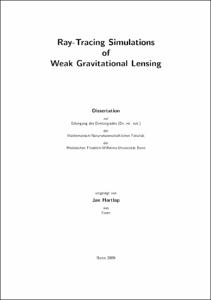Ray-Tracing Simulations of Weak Gravitational Lensing

Ray-Tracing Simulations of Weak Gravitational Lensing

| dc.contributor.advisor | Schneider, Peter | |
| dc.contributor.author | Hartlap, Jan | |
| dc.date.accessioned | 2020-04-14T00:43:05Z | |
| dc.date.available | 2020-04-14T00:43:05Z | |
| dc.date.issued | 02.07.2009 | |
| dc.identifier.uri | https://hdl.handle.net/20.500.11811/4088 | |
| dc.description.abstract | Weak gravitational lensing, i.e. the distortion of images of distant galaxies due to the deflection of light rays in gravitational fields, is a powerful method to study the matter distribution in the Universe. It can be used to put constraints on cosmological parameters by looking at the statistical properties of the distortion field (cosmic shear), or to study the relation of the galaxy distribution to the underlying distribution of the dark matter (galaxy-galaxy lensing; GGL). We use ray-tracing simulations of light propagation through the large scale structure of the Universe to study several aspects of the statistical analysis of weak lensing data and to test methods to constrain theories of galaxy formation using GGL. In the first part of this thesis, we discuss several issues regarding the estimation of cosmological parameters from weak lensing data. We point out that using a covariance matrix that is estimated from simulations or the data themselves can lead to a severe underestimation of the errors derived for cosmological parameters, and we report on a method to remove this bias. We then use ray-tracing simulations to test the assumption that the likelihood of the shear correlation functions is a multi-variate Gaussian. For that purpose, we develop and test a new method to estimate high-dimensional probability distributions. We find that the likelihood is significantly skewed and steeper than suggested by the Gaussian approximation. We apply this result to investigate possible reasons for the low value of the power spectrum normalization s8 found by Schrabback et al. (2007) in a cosmic shear analysis of the Chandra Deep Field South (CDFS). Both the assumption of a Gaussian likelihood and the way the CDFS was selected are found to bias s8 low, in total by approximately 15-20%. In the second part of this thesis, we use ray-tracing through a very large simulation of structure formation, the Millennium Simulation (MS), to investigate possibilities to constrain galaxy evolution models using galaxy-galaxy lensing. We introduce several improvements of the standard ray-tracing algorithm which allow us to fully exploit the large volume and high resolution of the MS. Galaxies from semi-analytic models of galaxy formation can be included in the ray-tracing, yielding realistic mock galaxy catalogs. Here, we use the model by De Lucia & Blaizot (2007). We compare our simulations to the measurements of the GGL signal in the Sloan Digital Sky Survey (Sheldon et al. 2004) and find an overall good agreement; only for the most luminous blue galaxies, the simulation predicts a signal smaller than observed. A possible reason for this is the insufficient modelling of dust attenuation in the semi-analytic model. We also find tentative evidence for a steepening of the GGL signal due to baryonic physics on small scales. Finally, we explore the possibilities of measuring the linear stochastic bias and correlation parameters (quantifying the relation between galaxies and dark matter) from measurements of weak lensing and angular clustering. We identify several sources of bias, the most important being the limited angular range for which the GGL signal and the angular correlation function can be measured. Furthermore, higher-order effects due to the coupling of lenses at different distances have to be taken into account, for which we provide analytical expressions. These issues depend strongly on scale and the galaxy samples used, and are best modelled using numerical simulations. | en |
| dc.language.iso | eng | |
| dc.rights | In Copyright | |
| dc.rights.uri | http://rightsstatements.org/vocab/InC/1.0/ | |
| dc.subject | Kosmologie | |
| dc.subject | schwacher Gravitationslinseneffekt | |
| dc.subject | Simulationen | |
| dc.subject | kosmologische Parameter | |
| dc.subject | statistische Methoden | |
| dc.subject | cosmic shear | |
| dc.subject | galaxy-galaxy lensing | |
| dc.subject | galaxy bias | |
| dc.subject.ddc | 520 Astronomie, Kartografie | |
| dc.title | Ray-Tracing Simulations of Weak Gravitational Lensing | |
| dc.type | Dissertation oder Habilitation | |
| dc.publisher.name | Universitäts- und Landesbibliothek Bonn | |
| dc.publisher.location | Bonn | |
| dc.rights.accessRights | openAccess | |
| dc.identifier.urn | https://nbn-resolving.org/urn:nbn:de:hbz:5N-17962 | |
| ulbbn.pubtype | Erstveröffentlichung | |
| ulbbnediss.affiliation.name | Rheinische Friedrich-Wilhelms-Universität Bonn | |
| ulbbnediss.affiliation.location | Bonn | |
| ulbbnediss.thesis.level | Dissertation | |
| ulbbnediss.dissID | 1796 | |
| ulbbnediss.date.accepted | 23.06.2009 | |
| ulbbnediss.fakultaet | Mathematisch-Naturwissenschaftliche Fakultät | |
| dc.contributor.coReferee | Eckart, Andreas |
Files in this item
This item appears in the following Collection(s)
-
E-Dissertationen (4442)




